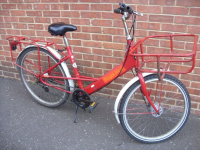BiggKidd
100 W
Hi all new member here and new to modern E-biking. Until last friday I hadn't been on a bike in roughly 40 years. Last week I took delivery of my new Ridstar E26 pro dual motor fat bike. Since then I've put about 150 miles on it running errands and getting groceries and such. I bought it for that as well as making some long bike trips. Which brings me to the point of this post I would like to mount a 105AH LifePO4 battery on the front forks. That would be 8 cells per side adding around 75 to 90 pounds to the front of the bike. It seems to me all bikes carry about 75-90% of the bike, rider and cargo weight on the rear tire. It would seem to me spreading the weight out more would help. Does anyone have any opinions or factual knowledge of putting heavy loads on the front wheel.
The reasons I would rather use LifePO4 over Li-ion are many starting with I have one in hand. Two they last much longer IE: about 6,000 to 8,000 charge cycles versus to 1,000 or so for Li-ion. They also have a much lower fire risk. Downside they are a little heavier and bulkier!
Thanks for any help / information in advance.
BTW I've been living on an off grid homestead way out in the sticks raising two now grown daughters for the last 17 years. It's a ways to anything from here! My long term goal for this bike is to see this country over the next ten years...
I should probably also add the fact that I have several health issues including M.S. and I am no spring chicken.
The reasons I would rather use LifePO4 over Li-ion are many starting with I have one in hand. Two they last much longer IE: about 6,000 to 8,000 charge cycles versus to 1,000 or so for Li-ion. They also have a much lower fire risk. Downside they are a little heavier and bulkier!
Thanks for any help / information in advance.
BTW I've been living on an off grid homestead way out in the sticks raising two now grown daughters for the last 17 years. It's a ways to anything from here! My long term goal for this bike is to see this country over the next ten years...
I should probably also add the fact that I have several health issues including M.S. and I am no spring chicken.







